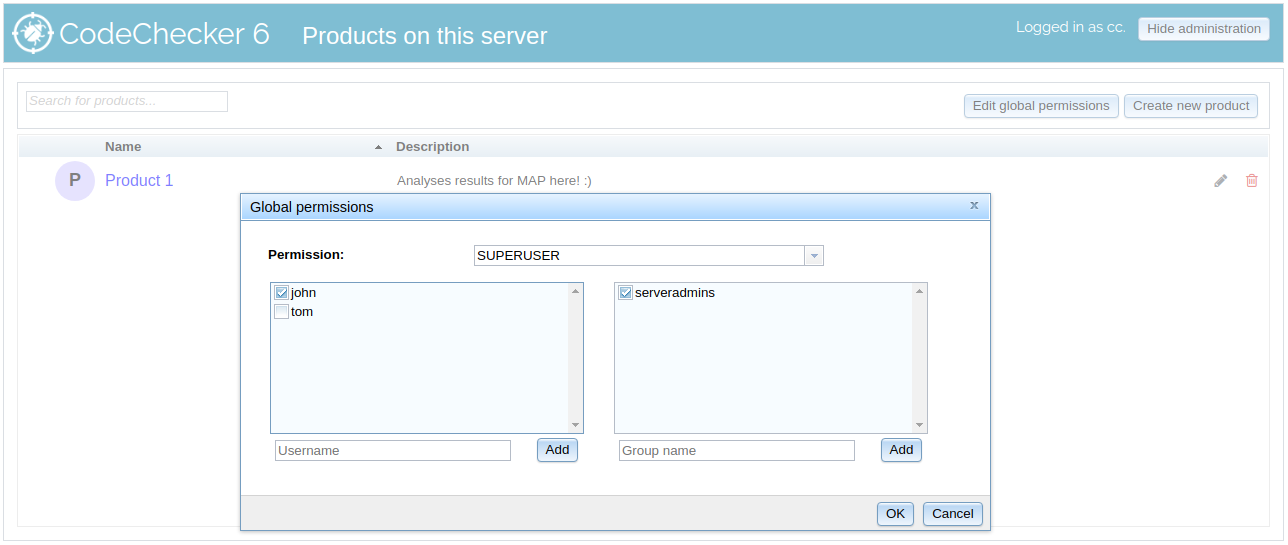To configure access demarcation between multiple products, CodeChecker has it's permission system. Each user can be assigned some permissions, and each action on the server requires a certain permission to be present - otherwise the action will fail.
The username and group values that permissions can be delegated to are retrieved via user credentials. For the permission system to work, authentication must be enabled, otherwise, the unauthenticated guest user will only have the default permissions given.
Different scopes of CodeChecker use different permissions. Currently, permissions can be defined on the server level (system/global permission), or on the product level.
Each CodeChecker server at its first start generates a master superuser (root) access credential which it prints into its standard output:
[WARNING] Server started without 'root.user' present in CONFIG_DIRECTORY!
A NEW superuser credential was generated for the server. This information IS
SAVED, thus subsequent server starts WILL use these credentials. You WILL NOT
get to see the credentials again, so MAKE SURE YOU REMEMBER THIS LOGIN!
-----------------------------------------------------------------
The superuser's username is 'AAAAAA' with the password 'aaaa0000'
-----------------------------------------------------------------These credentials can be deleted and new ones can be requested by starting
CodeChecker server with the --reset-root flag. The credentials are always
randomly generated.
If the server has authentication enabled, the root user will always have
access despite of the configured authentication backends' decision, and
will automatically have the SUPERUSER permission.
- Server-wide permissions can be edited by clicking Edit global permissions.
- Product-level permissions can be edited by clicking the edit icon for the product you want to configure the permissions for.
Permissions can be managed on the web interface. From the drop-down, select the permission you want to configure. The two lists show the users and groups known to the system - if a tick is present in its row, the given user or group has the permission directly granted. (Users who only have a certain permission through permission inheritance are not shown with a tick.)
Only the permissions you have rights to manage are shown in the drop-down.
You can edit multiple permissions opening the window only once. Simply tick or un-tick the users/groups you want to give the permission to or revoke from them. Clicking OK will save the changes to the database.
Each permission has a unique name, such as SUPERUSER or PRODUCT_ADMIN.
Permissions can either be not granted or granted by default.
Some permissions are default not granted, which means that only users whom are explicitly given the permission have it.
Some permissions are default granted, which means that initially, every user has the permission. However, if at least one user or group is explicitly given the permission, only the users who have the permission given will be able to utilise it.
If the server is running without authentication – in this case there are no "users" as everyone is a guest – every permission is automatically granted.
Certain permissions automatically imply other permissions, e.g. a
PRODUCT_ADMIN is automatically given every product-level permission.
Permissions achieved through inheritance are exempt from the default
behaviour mentioned above. If no user has the PRODUCT_ACCESS permission,
every user will have it (because it is a default granted permission), despite
an existing PRODUCT_ADMIN inheriting the permission.
Permissions have a clear "chain of command" set in CodeChecker. Only a user who
has permission A's manager permission can grant or revoke other users' rights
to A.
Developer guide: See the API documentation for the list of permissions and which API call requires which permission exactly.
| Default |
|---|
| Not granted |
The SUPERUSER permission is the highest possible permission available.
Superusers can manage and automatically have every permission in the system.
SUPERUSERis a dangerous permission to grant, as a superuser can immediately change everything on the server, from demoting other superusers to destroying analysis results!
| Default |
|---|
| Not granted |
The product administrator is responsible for the management of an individual product. They can edit the product's appearance (displayed name and description) and delegate other product-level permissions to other users.
Product administrators cannot change the URL or the database configuration of the product.
Product admins are automatically given other PRODUCT_ permissions.
| Default | Managed by | Inherited from |
|---|---|---|
| Granted | PRODUCT_ADMIN |
PRODUCT_ADMIN, PRODUCT_STORE |
The basic permission to access analysis results stored in the product. With this permission, the user can browse analysis results, comment, set review status, etc.
| Default | Managed by | Inherited from |
|---|---|---|
| Granted | PRODUCT_ADMIN |
PRODUCT_ADMIN |
Users need the PRODUCT_STORE permission to store analysis runs and to
delete existing analysis runs from the server.
